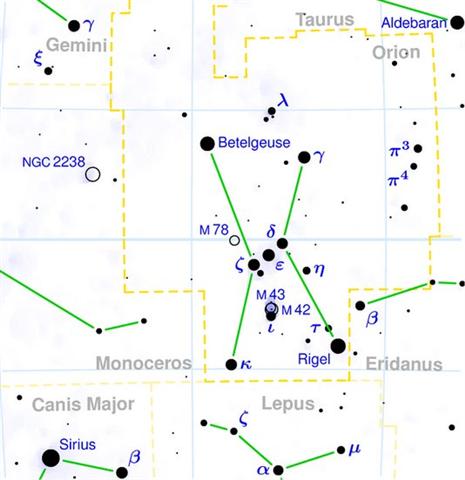Metoro mentioned toromiro also at Ca10-14, evidently
referring to the left part of the glyph:
 |
 |
5 |
|
Ca10-5 (260) |
Ca10-6 |
|
kua oho te rima kua kai - ihe nuku hoi |
Tupu te toromiro |
|
Dec 6 (340 = 157 + 183)
NODUS I =
ζ
Draconis
(260.0),
π
Herculis (260.7),
RAS ALGETHI
(Head of the Giant)
=
α
Herculis
(260.8) |
Dec
7 (264 + 77)
SARIN =
δ
Herculis
(261.0),
ο
Ophiuchi (261.4)
*220.0 = *261.4 - *41.4
ALRISHA (α Piscium) |
|
June 6 (314 / 2)
μ Aurigae, μ Leporis (77.6) |
June
7 (81 + 77)
ĸ Leporis (78.0),
RIGEL
(Foot) =
β
Orionis
(78.1),
Flaming Star = IC405
(78.2),
CAPELLA = α Aurigae (78.4),
ο
Columbae,
τ
Orionis (78.8)
*37.0 = *78.4 - *41.4
THUBAN (α Draconis) |
 |
 |
 |
|
Ca10-12 (260 + 7) |
Ca10-13 (268) |
Ca10-14 |
| te mauga tuu toga |
kua tupu te mea - i
te inoino |
ka tupu te toromiro
- i te inoino |
|
Dec 13 (Lucia)
λ
Arae (267.1),
GIRTAB (Seizer) =
κ
Scorpii,
ο
Serpentis (267.6),
DSIBAN (Wolf Pair) =
ψ
Draconis
(267.9) |
Dec 14 (348)
KELB ALRAI (Dog of the Shepherd) =
β
Ophiuchi,
μ
Arae (268.1),
KEW HO (Nine Rivers) =
μ
Herculis
(268.6),
η
Pavonis (268.7),
APOLLYON =
ι Scorpii
(268.9) |
Dec 15
MULIPHEN (Oaths) =
γ
Ophiuchi
(269.0),
BASANISMUS = G Scorpii
(269.5),
PHERKARD (Dim One of the Two Calves) =
δ
Ursae Minoris
(269.9) |

 |
|
June 13 (164)
MENKAURE
Three Stars-21 (Gibbon) /
Shur-narkabti-sha-shūtū-6 (Star in the Bull towards
the south) / ANA-IVA-9
(Pillar of exit)
HEAVENLY GATE
=
ζ
Tauri,
ν
Columbae (84.0),
ω
Orionis (84.2),
ALNITAK (Girdle)
=
ζ
Orionis,
PHAKT (Phaet)
=
α
Columbae
(84.7) |
June
14 (348 - 183)
ο Aurigae (85.8), γ Leporis (85.9)
YANG MUN
(α Lupi) |
June 15
μ
Columbae,
SAIPH (Sword) =
κ
Orionis
(86.5),
τ
Aurigae,
ζ
Leporis (86.6) |


|
Egyptian hand |
 |
Phoenician
kaph |
 |
Greek
kappa |
Κ (κ) |
|
Kaph is thought to have
been derived from a pictogram of a hand (in both
modern Arabic and modern Hebrew, kaph
means palm/grip) ...
... The
manik, with the tzab, or serpent's
rattles as prefix, runs across Madrid tz. 22 ,
the figures in the pictures all holding the
rattle; it runs across the hunting scenes of
Madrid tz. 61, 62, and finally appears in all
four clauses of tz. 175, the so-called 'baptism'
tzolkin. It seems impossible, with all this, to
avoid assigning the value of grasping or
receiving. But in the final confirmation, we
have the direct evidence of the signs for East
and West. For the East we have the glyph
Ahau-Kin, the Lord Sun, the Lord of Day; for
the West we have Manik-Kin, exactly
corresponding to the term Chikin, the
biting or eating of the Sun, seizing it in the
mouth.



The pictures (from Gates) show
east, north, west, and south; respectively (the
lower two glyphs) 'Lord' (Ahau) and
'grasp' (Manik). Manik was the 7th
day sign of the 20 and Ahau the last ... |
|
|